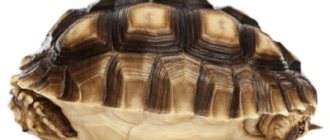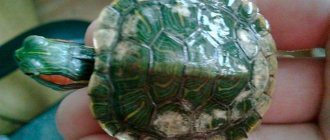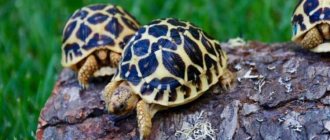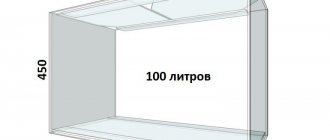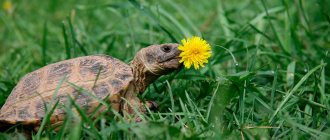Treatment of rickets in red-eared turtles
If your turtle shows signs of incipient rickets, it is best to immediately contact a veterinarian. The doctor will be able to determine how advanced the disease is, and based on this, prescribe the necessary course of treatment. To begin with, you should introduce into your turtles' diet foods that contain vitamin D (egg yolk, cottage cheese, fish liver, cheese, herbs), vitamin A (grated carrots, beef liver), as well as foods rich in calcium (clams, garden snails) , shrimp, bone meal, etc.).
As a last resort, you can go to a pet store, where there is a wide range of mineral supplements that can be fed to turtles with rickets.
If signs of rickets are detected, it is advisable to begin irradiating the pet with a quartz lamp. Sessions can last 15 minutes at a distance of 20-25cm from the lamp.
If the disease is advanced, the doctor may prescribe injections of calcium-containing medications. As a result of intensive therapy, using all the recommendations, the disease can be completely defeated within 1.5-2 months.
Eye diseases
Symptoms of eye disease (conjunctivitis) are as follows:
- swollen, reddened eyelids;
- discharge of pus around the edges of the eyes;
- the turtle tries to rub its eyes with its paws;
- decreased appetite, lethargic behavior.
This disease is caused by staphylococci or streptococci, which grow in dirty water.
At the initial stage, conjunctivitis is treated with ordinary eye drops (dropped 2 times a day), and for acute conjunctivitis, antibiotic-based eye ointments are used.
In general, to eliminate the prerequisites for such eye diseases, you need to visit the aquaterrarium more often and keep it clean.
A dangerous disease is salmonellosis, caused by intestinal bacteria. The animal develops loose stools with a very unpleasant odor, general apathy, and weight loss.
This disease can only be treated in a veterinary clinic, and the sooner the turtle’s owner goes there, the better. Otherwise, the death of your pet is inevitable.
Prevention of rickets
Rickets, like any other disease, is easier to prevent than to treat if the animal is properly cared for, providing it with comfortable living conditions close to natural ones.
To prevent rickets in red-eared turtles, you should pay attention to:
- On a high-quality and varied diet, rich in all the necessary nutrients to ensure normal growth.
- To carry out additional sunbathing in the summer, for which you need to acquire an outdoor enclosure.
- On the size of the terrarium: it should be spacious and not limit the movement of the animal. All conditions should be created for the active, dynamic development of the pet, otherwise, as a result of physical inactivity, weakening of the immune system, dysfunction of the musculoskeletal system, decreased efficiency of the circulatory system, and slowdown of digestive processes are possible, which can lead to the appearance of a whole lot more in the red-eared turtle, in addition to rickets. bouquet of diseases.
- Since the amount of sunbathing is sharply reduced in winter, it should be regularly irradiated with a quartz lamp. At the same time, it is advisable to diversify your diet and increase the amount of food rich in calcium, vitamins A and D.
Hearing diseases
The most common disease affecting the auditory organs is otitis media. The severity of otitis is that the disease goes unnoticed for a long time, as it often develops asymptomatically, and subsequently leads to serious problems.
You can identify the presence of otitis media in a pet by the following signs:
- The turtle's cheek is swollen and asymmetry is noticeable.
- The pet becomes apathetic and turns away from food.
- The turtle's coordination of movements is impaired.
Otitis in reptiles can be unilateral or bilateral, when swelling is observed on one side, or both cheeks of the turtle are swollen. With the development of otitis, veterinarians assume the following consequences:
- The release of pus through the skin.
- Exit of purulent discharge through the mouth.
- The need for surgical intervention.
If the pus comes out through the skin, the resulting wound is treated with disinfectants. If no breakthrough is observed, the area where pus accumulates is massaged, stimulating exit through the mouth. If attempts fail, surgery is required. After removing the pus, the animal is provided with good nutrition, vitamin complexes and the administration of calcium gluconate.
Diagnosis of the disease
Diagnosis of the disease is carried out after the following studies:
- Visual examination of the baby, interview with parents.
- Palpation of affected areas (joints, sternum, skull).
- Studying the medical history of the mother and child, including the period of pregnancy and mode of delivery.
- Taking a urine sample according to Sulkovich to determine the quantitative calcium content. The test is taken in the morning on an empty stomach; in a couple of days, all foods with a high calcium content are removed from the diet of the baby or mother (in case of lactation). Normally, a child should have an indicator of 2, but in rickets children it is often negative. The test is also used to monitor therapy.
- Donating blood to determine phosphatase activity, phosphorus and calcium concentrations and other parameters that affect the normal absorption of vitamin D.
- X-ray of the skeleton.
- Ultrasound examination of individual skeletal fragments.
The final diagnosis is made by a pediatrician or orthopedist.
Basic requirements for keeping a Central Asian land turtle:
- Special ultraviolet lamp for reptiles with UV-B spectrum from 10% (UV lamps from quality manufacturers are changed once a year)
- Heating lamp. An incandescent light bulb will do
- Spacious terrarium with warm (30-33° C) and cold (22-25° C) corners
- The right soil. Sandy loam recommended
- Feeding on weeds (needs to be frozen or dried for the winter) + calcium supplement once a week
- Bathing once a week + drinking bowl in the terrarium
To summarize, I would like to note that, in general, a turtle is not difficult to keep. Keeping a Central Asian turtle is fundamentally different from keeping other pets (for example, a dog or a cat). She doesn't need to show too much attention, get vaccinated, or feed every day. This animal is not at all expensive: the terrarium is purchased once, and a high-quality UV lamp is changed once a year. But, nevertheless, the basic requirements must be met so that your pet pleases you not just for one year, but for decades!
Parasites in the gastrointestinal tract
Turtles are often found to have various parasites that affect the digestive system. Worms can be found in individuals of different ages. Typically, round and tapeworms enter the body of an amphibian animal along with food.
If your pet has worms, the following signs will indicate this:
- abnormal stool. Sometimes worms may be found in the stool;
- rapid loss of body weight;
- the reptile experiences complete apathy, it can be passive, constantly sleep or sit in one place;
- sunken eyes.
If suddenly the above signs are found in a reptile, then it will be possible to say for sure that it has worms. But to establish a diagnosis, it is better to take stool tests and visit a veterinarian. In these cases, constant medical supervision is required.
Worms can be eliminated quickly in the earliest stages of infection. But it is worth considering that the more advanced the disease, the more difficult it will be to cure.
Description
The low carapace (carapace) is almost oval; if you look at it from above, you can see that the width in the back is slightly wider than in the front. The length of the shell is 20 cm or more in adult large turtles. Since water has always been the key habitat for turtles, the carapace scutes naturally fit perfectly together. In terms of their structure, the carapace and plastron are completely streamlined and have no protrusions. Large claws are located on the legs, small membranes are located between the toes. The claws of a swamp turtle can easily tear prey apart and can significantly scratch your hand. The tail of this turtle is relatively long, can reach 3/4 of the length of the carapace (about 12 cm) and during swimming it takes part as an auxiliary rudder during any turns (the main steering is carried out by the legs) and as a counterweight that holds the turtle in the required position during maneuvers. The carapace usually has a dark olive, dark green, sometimes almost black color, the plastron is light, yellowish. The shell, neck, head, legs are covered with small light spots. Often females have yellow eyes, while males are slightly reddish. Females have slightly shorter tails than males.
Preventive actions
Preventative measures to prevent the development of vitamin D deficiency in an infant include:
- daily walks with the baby outside (it is necessary to “expose” the baby’s face to the sun’s rays in cold northern latitudes);
- hardening the child;
- daily gymnastics;
- children's massage (both independent and restorative, performed by a specialist);
- preventive intake of an oil or water solution of vitamin D in consultation with your doctor
- preventive courses of UV irradiation for an infant (up to 20 sessions in a row, also as prescribed by a pediatrician); after completing the course, it is necessary to stop taking vitamin D for up to one month.
Rectal prolapse – prolapse of the rectum
Turtles often suffer from such an unpleasant illness as rectal prolapse - prolapse of the rectum. The causes of this problem can be various factors - anatomical disorders in the development of the intestine, it can occur due to the turtle eating sand or hard soil. Cloaca prolapse can be caused by constipation or enteritis.
In males, prolapse of the genital organ may occur. It should only be adjusted by a veterinary specialist; this procedure cannot be performed independently at home. After repositioning the cloaca, the tail is fixed with adhesive tape. In this case, Vaseline oil must be administered orally. It is mandatory to carefully monitor the pet over the next week. This will help to promptly identify relapse or problems with bowel movements.
Why is this happening
During labor, even if it goes well, the newborn's head has to face a number of difficulties. Even an easy birth for the mother can be difficult for the baby: the baby walks head first, the bones of the mother’s pelvis, the muscles of the pelvic floor and the genital organs put pressure on his skull, so the delicate bones are subject to displacement.
It should be noted that the skull is not a single bone, it consists of many individual bones that are connected by sutures. The baby’s seams are still elastic, mobile, and not fully secured. This is what helps the bones of the skull move during childbirth, as if overlapping each other, changing the shape of the head and facilitating the birth process. This mechanism was invented by nature itself because the diameter of the newborn’s skull is larger than the diameter of the mother’s birth canal. After birth, the bones of the skull normally “straighten.” The head regains its normal shape.
Dystocia – delayed egg laying
Sometimes freshwater animals experience a disease in which there is a delay in egg laying. At home, it can appear due to non-compliance with the temperature regime in the aquaterrarium, as well as due to an increased level of calcium in the pet’s body.
How can you identify the presence of dystocia:
- the female can dig a hole to lay eggs, but she does not lay them there;
- the pet may have apathy, passivity, lethargy;
- in females the process of laying eggs begins, but does not complete;
- individuals do not want to eat, they lose their appetite;
- Sometimes there are signs of shortness of breath.
In these situations, it is better to contact a veterinarian. Violation of egg laying can only be detected with a full examination using ultrasound and x-rays.
How to Properly Give Your Turtle Vitamin and Mineral Supplements
Companies specializing in the production of veterinary drugs offer vitamins for reptiles and mineral complexes in the following forms:
- single-component and multi-component powders that are added to food;
- drops (added to water);
- vitamins in tablets - added to the main feed.
Important! Before using the drug, carefully read the instructions for use. Dosage may depend on the following factors: age of the pet, health status, weight of the reptile
Vitamins for the land turtle, as well as for its relatives, have some differences. Calcium is of great importance for absolutely all types of turtles, since it directly affects the bones and development of the individual. But other vitamins must be introduced after first studying the necessary information about the needs of the species.
We invite you to read: Review of effective cat vitamins
For example, vitamins for red-eared turtles are needed in much smaller quantities than for its relative the Central Asian land turtle. Basically, reptiles are divided into two types that require vitamin complexes.



